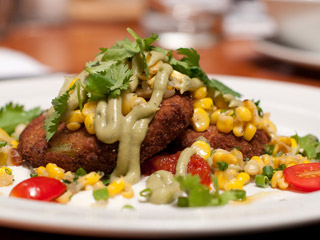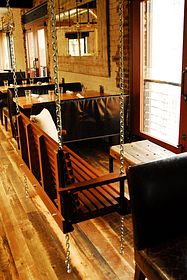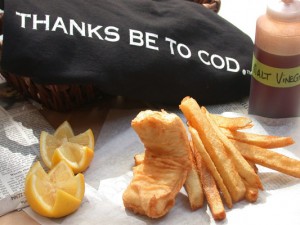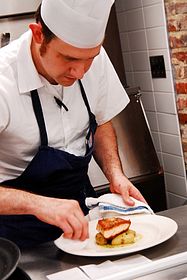 Last week I was in Washington DC to spend Thanksgiving with my girlfriend. While I was there, she took me to her new favorite restaurant, Virtue, in Old Town Alexandria. I loved it as much as she did and we decided that while I was in town, we should also visit the other four establishments owned by the Eat Good Food Group.
Last week I was in Washington DC to spend Thanksgiving with my girlfriend. While I was there, she took me to her new favorite restaurant, Virtue, in Old Town Alexandria. I loved it as much as she did and we decided that while I was in town, we should also visit the other four establishments owned by the Eat Good Food Group.
They were all fantastic. And crowded. Which got me to thinking about how this ownership team has managed to successfully grow their business in the most failure-prone industry known to man, during one of the worst economic periods of our nation’s history.
Here are four observations and thoughts for your own sales:
1. Have a clear vision
The partners in the Eat Good Food Group—husband and wife Cathal and Meshelle Armstrong and their friend Todd Thrasher—created each restaurant with a very clear vision in mind: Virtue is a casual tavern; The  Majestic is an upscale eatery serving American classics; Restaurant Eve is a French-influenced fine dining experience; Eamonn’s is an Irish fish-and-chips place; and PX is a lounge that evokes a 1920’s-era speakeasy. The vision for each establishment manifests in details such as the lack of signage on PX’s door, the Irish sodas at Eamonn’s, and the gas-station-style shirts worn by the wait staff at Virtue. Each restaurant has a distinct look and feel that distinguishes it from competitors.
Majestic is an upscale eatery serving American classics; Restaurant Eve is a French-influenced fine dining experience; Eamonn’s is an Irish fish-and-chips place; and PX is a lounge that evokes a 1920’s-era speakeasy. The vision for each establishment manifests in details such as the lack of signage on PX’s door, the Irish sodas at Eamonn’s, and the gas-station-style shirts worn by the wait staff at Virtue. Each restaurant has a distinct look and feel that distinguishes it from competitors.
What’s your vision for your business? How do you want your customers to feel when they walk into your place of business or experience your product or service? And how does that experience differ from what your competition provides?
2. Do fewer things better
The menus at all five restaurants are pretty limited. (Heck, Eamonn’s pretty much serves only fish and chips.) While this would seem to be a disadvantage compared to many other restaurants, where the menu choices seem to go on forever, the Armstrongs and Thrasher have realized an important point: It’s better to do a few things incredibly well than do a lot of things unexceptionally.
Too many businesses try to do too much, in a doomed effort to be all things to all people. You can’t please everyone, and you’ll drive yourself crazy trying. Instead, harness the power of focus: Offer less, but make what you do offer, extraordinary.
3. Hire good people and train them well
 Another element all five restaurants share is the quality of the people who work in them. From the hosts to the chefs to the wait staff to the managers, everyone is friendly, knowledgeable, skilled and helpful. They clearly enjoy being where they are and doing what they do, an attitude customers appreciate.
Another element all five restaurants share is the quality of the people who work in them. From the hosts to the chefs to the wait staff to the managers, everyone is friendly, knowledgeable, skilled and helpful. They clearly enjoy being where they are and doing what they do, an attitude customers appreciate.
Your people are your business. Do you have the right people? Do you have enough of them? Are you training them consistently so they can continuously improve?
4. Make customers feel great
Whether you’ve just dropped $200 on the Tasting Room menu at Restaurant Eve or spent less than $10 on an enormous portion of fish & chips at Eamonn’s, you walk out feeling wonderful. That may seem easy in an industry based on feeding  people, but I’ve walked out of plenty of restaurants where I wasn’t particularly enthusiastic about my experience there. (I’m sure you have as well.)
people, but I’ve walked out of plenty of restaurants where I wasn’t particularly enthusiastic about my experience there. (I’m sure you have as well.)
Business is all about feelings. There may be a lot of numbers, facts and logic involved, but the bottom line is that people buy when they feel good about a company or a salesperson. And they return when the experience creates a positive emotional imprint on them.
How do your customers feel when they do business with you? How does your product or service make them feel? How could you improve their experience?
Whenever you see a successful business, take a few minutes to think about what they’re doing right and how you might incorporate it into your own business. And the next time you’re in the Washington DC area, check out one or more of the Eat Good Food Group restaurants. Tell them I said hi.

Leave a comment